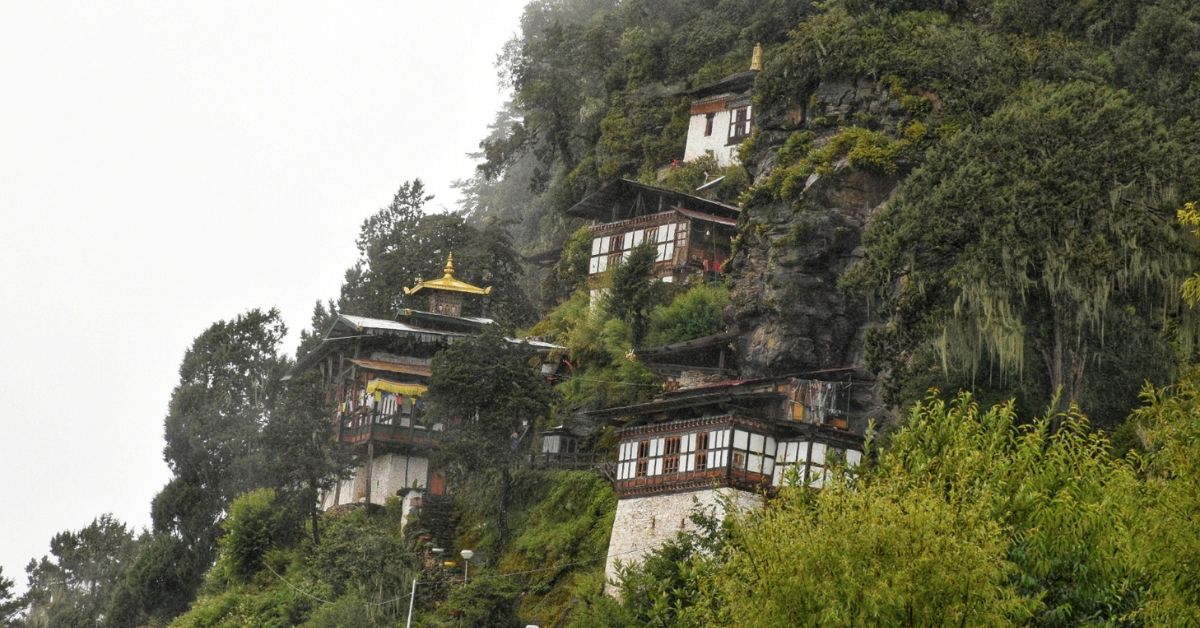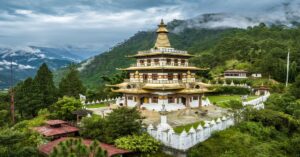Kunzangdra is one of the four cliffs of Guru Rinpoche, located opposite the Tang Valley of Bumthang Dzongkhag at 3350 meters above sea level. The name Kunzangdra is derived from the incident of Pema Lingpa seeing Kuntu Zangpo, one of the primordial Buddhas, while gazing up from his birthplace, Chel.
According to Guru Rinpoche’s prophecy, Terton Pema Lingpa built the Kunzangdrak Monastery on the face of a cliff in 1488. The monastery has three temples, the Wangkhang, Oezerphug, and the Khandro Lhakhang, in addition to Pema Lingpa’s living quarters, which are now Goenkhang.
Kunzangdra Monastery is one of the Four Cliffs (Dra Zhi) of Guru Rinpoche in Bumthang valley. The other three cliffs are Shukdrak in Choekhor, Choedrak in Chumey, and Thowadrak in Tang Valley under the Bumthang Dzongkhag in central Bhutan.
How to Reach Kunzangdrak Monastery
Kuenzang Drak Monastery is 19 km from Chamkhar Town. It takes a half-hour hike to reach there on foot from the parking. The Kunzangdra Monastery hike in Bumthang Tang is rated as moderate in difficulty.
Sacred Relics to See at Kunzangdrak
- Footprints of Guru Rinpoche;
- A life-like figure of Pemalingpa;
- The golden footprint of Pema Lingpa;
- A stone throne of Pema Lingpa;
- The meditation cave of Pema Lingpa’s son;
- A holy spring (Drupchhu) that cures epilepsy and stroke;
- Pema Lingpa’s meditation cave;
- A chorten that houses the remains of Pema Lingpa’s mother.
Also Read: Guru Rinpoche in Bhutan: His Visits to Bhutan and Sacred Sites
Historical Significance of Kunzangdra
Kunzangdra is one of the Dra Zhi (Four cliffs) of Guru Rimpoche. The other three cliffs are Choedrak in Chumey, Shugdrak in Choekhor, and Thowadra in Tang Valley.
The whole area is in the shape of Choeku Kuntu Zangpo (Buddha Samantabhadra), and the cave is located in the center (heart) of this area. That is why it is called Kunzang Drak. It is a sacred place where Guru Padmasambhava came riding on a tigress to the place and meditated in the 8th century. The footprints left on the rocks near the site testify to his visit.
Pema Lingpa is said to have once seen Kuntu Zangpo (Samantabhadra), one of the primordial Buddhas, while gazing up from his birthplace of Chel; the name Kunzangdra is derived from the occurrence. In 1488, Pema Lingpa constructed a Lhakhang on the site and designated it as one of his residences.
The sixth Namkhai Nyingpo also visited and conducted several religious practices such as meditation and prayer.
Description of Kunzangdrak
The main relic is a cave where Pema Lingpa meditated. Oezerphug is the meditation cave of Pema Lingpa’s son, Thugse Dawa Gyeltsen. There is a holy water called Tshepamey Drupchhu offered to Pema Lingpa by Tshepamey.
Also Read: Drupchhu or Holy Spring Waters in Bhutan: Beliefs and Benefits
Kunzangdrak contains a lovely collection of woodblocks and various stone footprints. It also has clay and copper graphics. Several stone structures can be seen throughout the mountain and on the rock face. Among them is the self-arisen face of Zambala on a cliff.
One can also find a holy spring (Drupchhu) of Terton Pema Lingpa, supposed to cure epilepsy and stroke. It is said that Pema Lingpa revealed this holy water by piercing the cliff with his finger. Further up, one can also see the Latsho (life lake) of Drasung Rahula.
Kuenzangdrak Monastery
The Kunzangdrak monastery consists of 3 temples. The oldest and main temple is Wangkhang Lhakhang, built by Pema Lingpa to bestow his blessing to the people. It is called the Wangkhang Lhakhang. The Lhakhang has a copper-gilded self-speaking statue of Pema Lingpa called a ‘Nga Drama‘ or ‘Just Like Me‘ statue sculptured by himself, a golden footprint, and a stone throne. Near the cliff, there is a chorten that houses the remains of Pema Lingpa’s mother.
Chenrezig is the main statue of Wangkhang, sculpted by Pema Lingpa himself. Three major statues, Amitabha on the left, Chuchezhey in the center, and Guru Nangsi Zilyon on the right, are also housed in the Wangkhang. All three statues were said to have been discovered and transported from Pema Lingpa’s Mani Gonpa, located southwest of Kunzangdra. Aside from these three statues, the temple also features a statue of the 6th Namkhai Nyingpo.
Pema Lingpa’s son Thugse Dawa Gyeltsen also built a temple and meditated there. This second temple is called Thuksey Dawai Drubkhang. He also constructed a Chorten near a wooden post imbued with the life energy of hundreds of Dakinis. The tree near the Chorten is believed as the walking stick of Thugse Dawa Gyeltshen.
Khandro Lhakhang, the Temple of Dakinis, was founded on the same site where Khandro Yeshey Tshogyal is said to have meditated. Pema Lingpa’s consort also meditated here. It is said that hundreds of thousands of Khandroms built the base, which was then guarded by guardian deities under the guidance of Drasung Rahula. There is also a Khandro Drupchhu.
The Gangtey Tulku oversees the monastery, including a small monastic school apart from his main seat at Gangtey Monastery.
Also Read: Dra Zhi, the Four Great Meditation Cliffs of Guru Rinpoche in Bumthang
Best Time to Visit Kunzangdra Monastery
There is no perfect time for a pilgrimage. You don’t need to visit the sacred sites at a specific time to seek blessings. Our culture and tradition, however, must be respected. Every religious place has its own set of customs that must be obeyed. If you wish to visit all of the sacred sites in Kunzangdrak, you must wait until the harvesting season is through, after the 15th day of the 9th month in the Bhutanese calendar.
You can contact Lam Sangay, the site manager of Kunzangdrak Monastery, at 17531137. You can visit major pilgrimage sites of Bumthang with the Bhutan Pilgrimage Package.
Enjoyed reading this blog?




